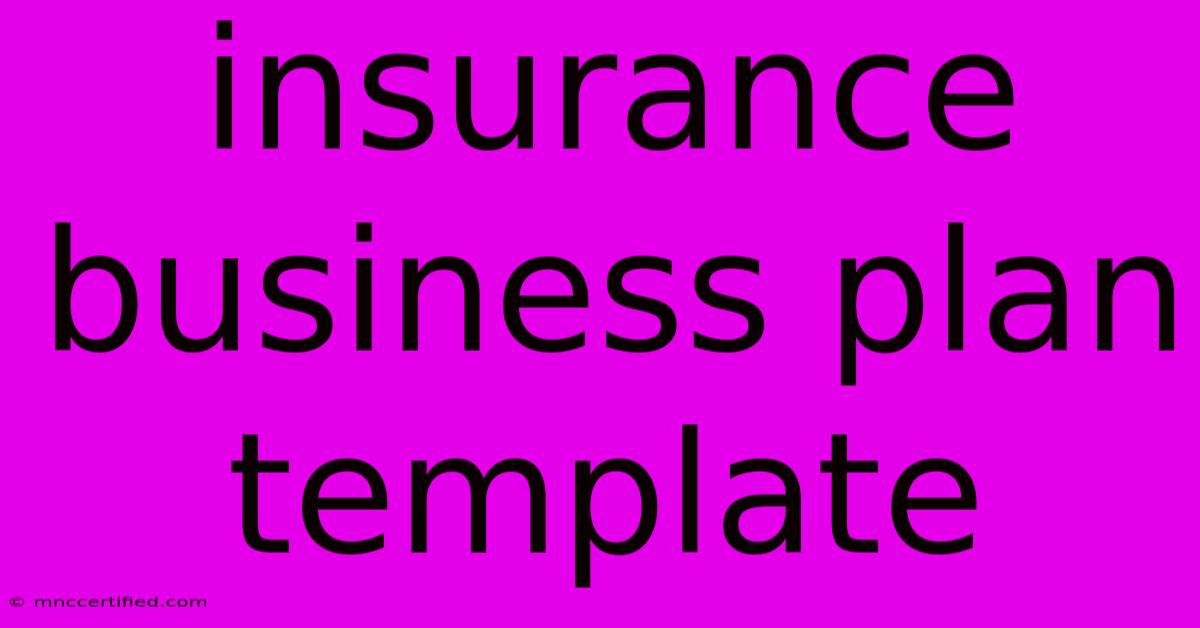Insurance Business Plan Template

Table of Contents
Insurance Business Plan Template: A Comprehensive Guide to Success
Starting an insurance business requires meticulous planning. A well-crafted insurance business plan template is crucial for securing funding, attracting investors, and guiding your company's growth. This comprehensive guide will walk you through creating a winning plan, covering everything from market analysis to financial projections.
I. Executive Summary: Setting the Stage
The executive summary is your elevator pitch – a concise overview of your entire business plan. It should highlight your mission, target market, competitive advantages, and financial projections. Write this after completing the rest of your plan, as it will summarize your key findings and conclusions. Think of it as the most important section – it's often the only part investors initially read.
Key Elements of Your Executive Summary:
- Mission Statement: Clearly define your insurance company's purpose and values.
- Company Description: Briefly describe your business model, type of insurance offered (life, health, auto, etc.), and unique selling proposition (USP).
- Market Analysis: Summarize your target market research, including demographics and competitive landscape.
- Financial Highlights: Include key financial projections, such as revenue forecasts and profitability analysis.
- Funding Request (if applicable): State the amount of funding you are seeking and how it will be used.
II. Company Description: Defining Your Insurance Business
This section delves deeper into your insurance company's details. Be specific and thorough.
Key Aspects to Include:
- Legal Structure: Sole proprietorship, partnership, LLC, or corporation? Explain the chosen structure and its implications.
- Products and Services: Detail the specific insurance products you'll offer. Will you specialize in a niche market?
- Value Proposition: What makes your insurance company stand out from competitors? Focus on your unique selling points. Are you offering lower premiums, superior customer service, specialized coverage, or a combination thereof?
- Management Team: Introduce your key personnel and highlight their experience and expertise in the insurance industry. Investors will want to see a capable team.
III. Market Analysis: Understanding Your Landscape
Thorough market research is vital. This section demonstrates your understanding of the insurance industry and your target market.
Crucial Components:
- Target Market: Define your ideal customer(s). Be specific with demographics (age, income, location, lifestyle) and their insurance needs.
- Market Size and Trends: Research the size of your target market and identify any relevant industry trends. Are there emerging needs or shifts in consumer preferences?
- Competitive Analysis: Identify your main competitors and analyze their strengths and weaknesses. How will you differentiate yourself? Analyze their pricing strategies, marketing approaches, and customer service.
- SWOT Analysis: Conduct a Strengths, Weaknesses, Opportunities, and Threats analysis to gain a comprehensive understanding of your position in the market.
IV. Organization and Management: Your Team and Structure
This section outlines your company's organizational structure and management team.
Essential Information:
- Organizational Chart: Illustrate the hierarchy and reporting structure within your company.
- Key Personnel: Provide detailed biographies of your management team, emphasizing their relevant experience and expertise.
- Advisory Board (if applicable): Include information on any advisors who will provide guidance and support.
V. Service or Product Line: Your Insurance Offerings
Clearly describe the insurance products or services your company will offer.
Key Details:
- Specific Products: Detail each insurance product, outlining coverage, benefits, and pricing strategies.
- Distribution Channels: How will you sell your insurance products? Direct sales, agents, brokers, or online platforms?
- Technology and Systems: Outline the technology and systems you'll use to manage your business, including policy management software and claims processing systems.
VI. Marketing and Sales Strategy: Reaching Your Customers
This section outlines your plan to acquire and retain customers.
Effective Strategies:
- Marketing Plan: Detail your marketing strategy, including branding, advertising, public relations, and digital marketing efforts.
- Sales Process: Describe your sales process, including lead generation, customer acquisition, and client retention strategies.
- Customer Relationship Management (CRM): Explain how you'll manage customer relationships to ensure client satisfaction and loyalty.
VII. Funding Request (if applicable): Securing Capital
If you're seeking funding, this section is critical.
Essential Elements:
- Funding Amount: Specify the amount of funding you require.
- Use of Funds: Clearly outline how the funds will be used.
- Financial Projections: Provide detailed financial projections, demonstrating the potential return on investment.
VIII. Financial Projections: Demonstrating Viability
This is a critical section for investors. Include detailed financial statements.
Important Financial Statements:
- Income Statement: Project your revenue, expenses, and profits over a period of 3-5 years.
- Balance Sheet: Project your assets, liabilities, and equity over the same period.
- Cash Flow Statement: Project your cash inflows and outflows.
- Break-even Analysis: Determine the point at which your revenue equals your expenses.
IX. Appendix: Supporting Documentation
Include any supporting documents that strengthen your business plan.
Useful Appendices:
- Resumes of key personnel
- Market research data
- Letters of support
- Permits and licenses
By following this insurance business plan template, you'll create a robust and compelling document that increases your chances of success. Remember, thorough research, realistic projections, and a clear understanding of your target market are key to creating a winning plan. Good luck!

Thank you for visiting our website wich cover about Insurance Business Plan Template. We hope the information provided has been useful to you. Feel free to contact us if you have any questions or need further assistance. See you next time and dont miss to bookmark.
Featured Posts
-
Auto Insurance Bonita Springs Fl
Nov 22, 2024
-
Pete Wicks Jowita Relationship Update
Nov 22, 2024
-
Will Insurance Cover A Door Ding
Nov 22, 2024
-
Coral Torres Cruz Wsps Us Grant Leader
Nov 22, 2024
-
Watch Steelers Vs Browns Channel Info
Nov 22, 2024